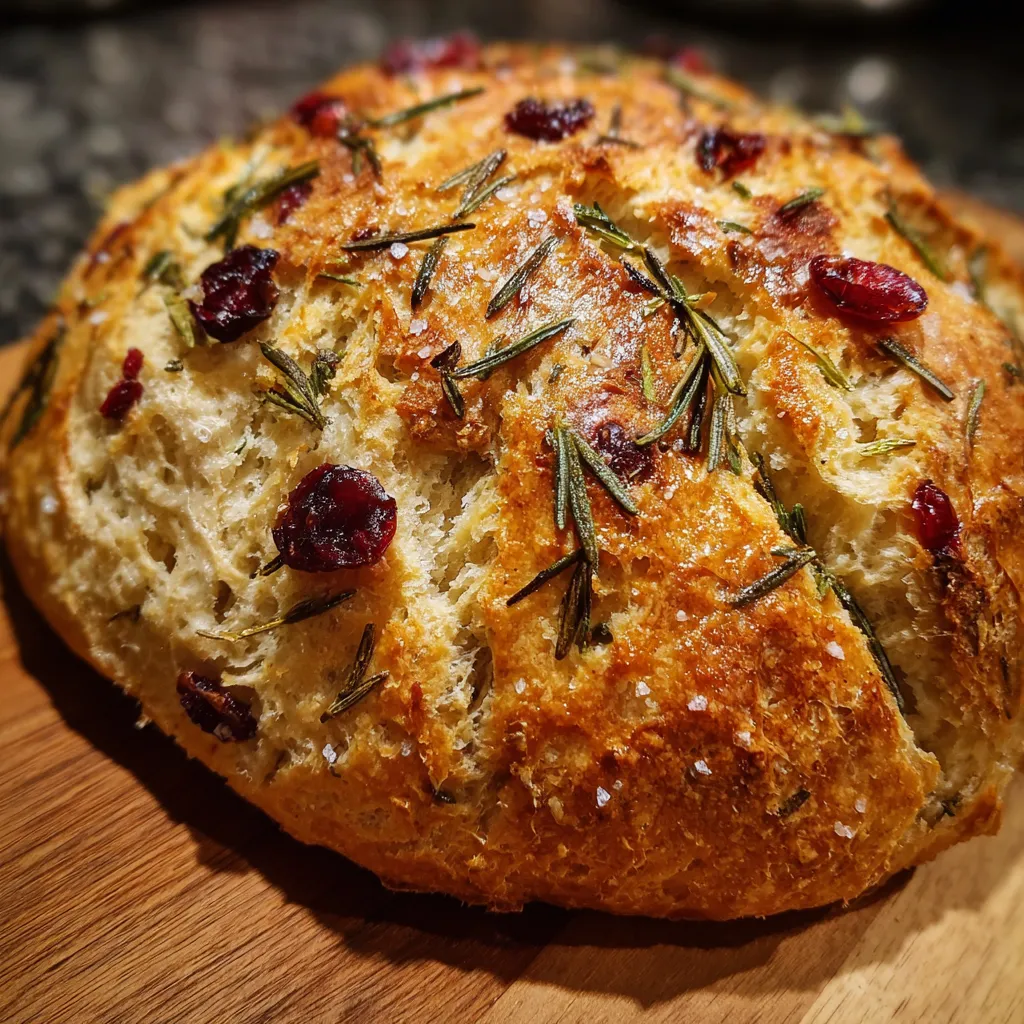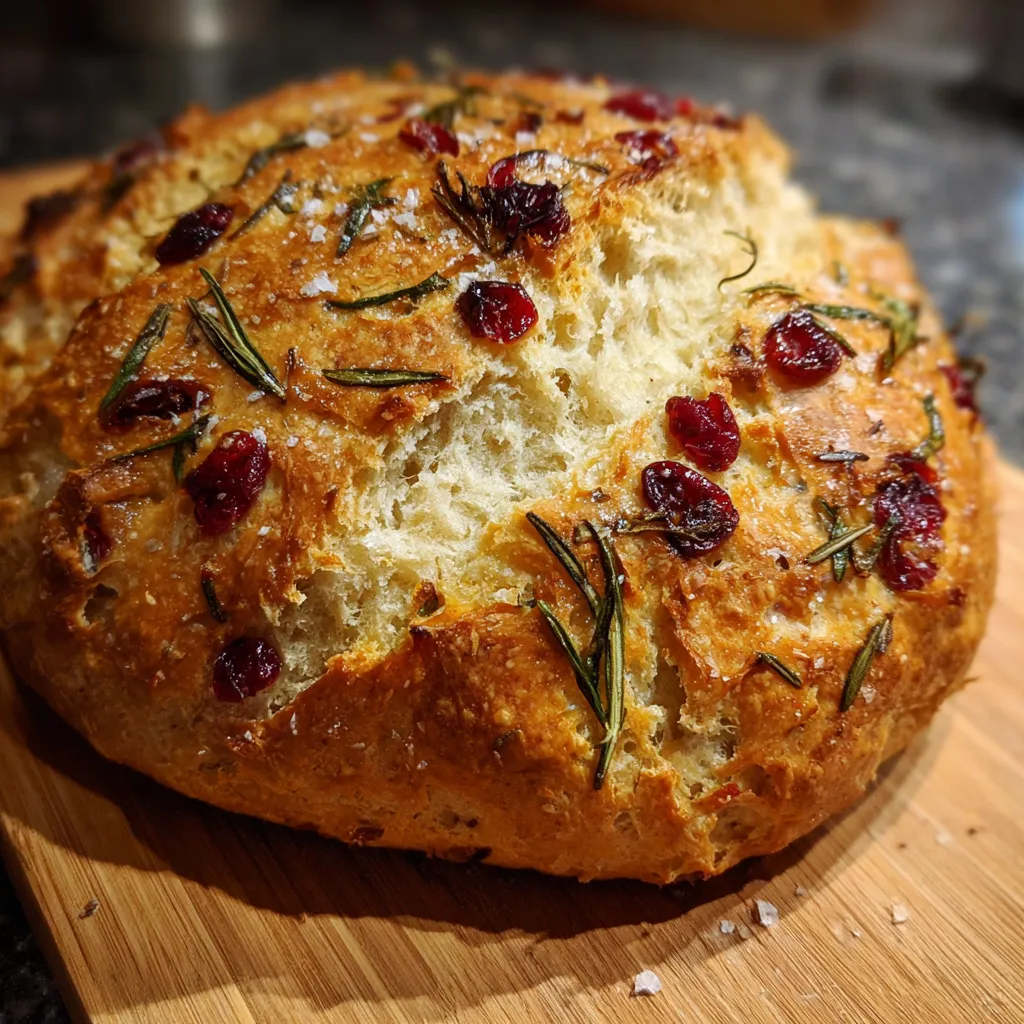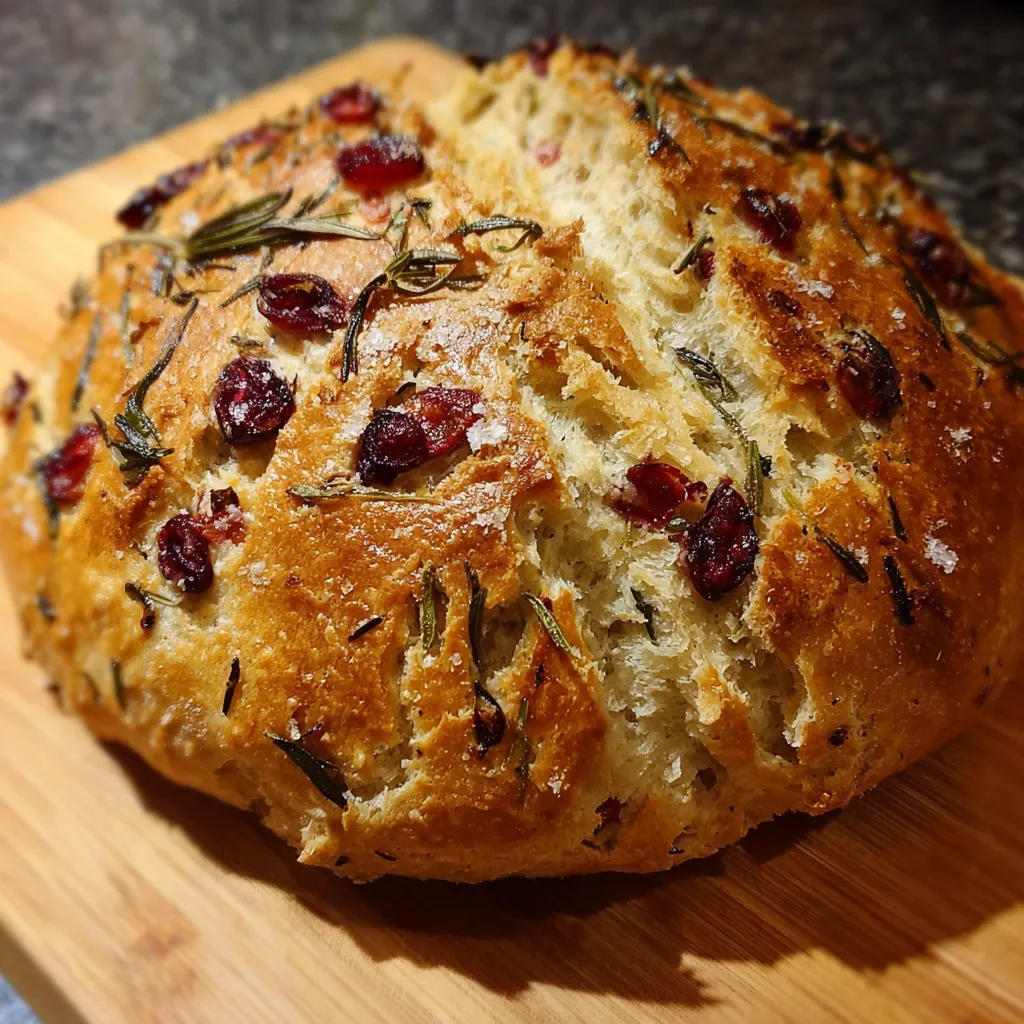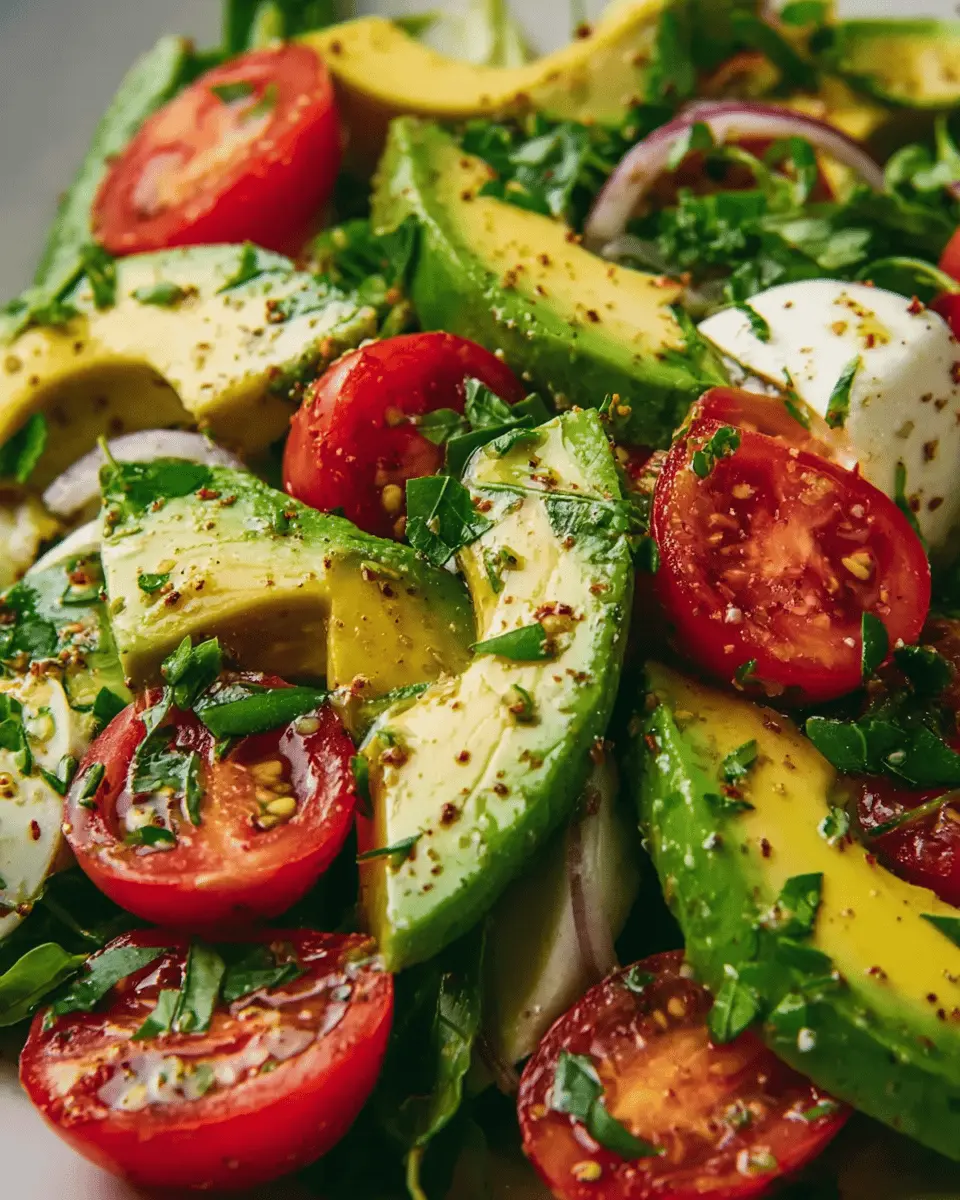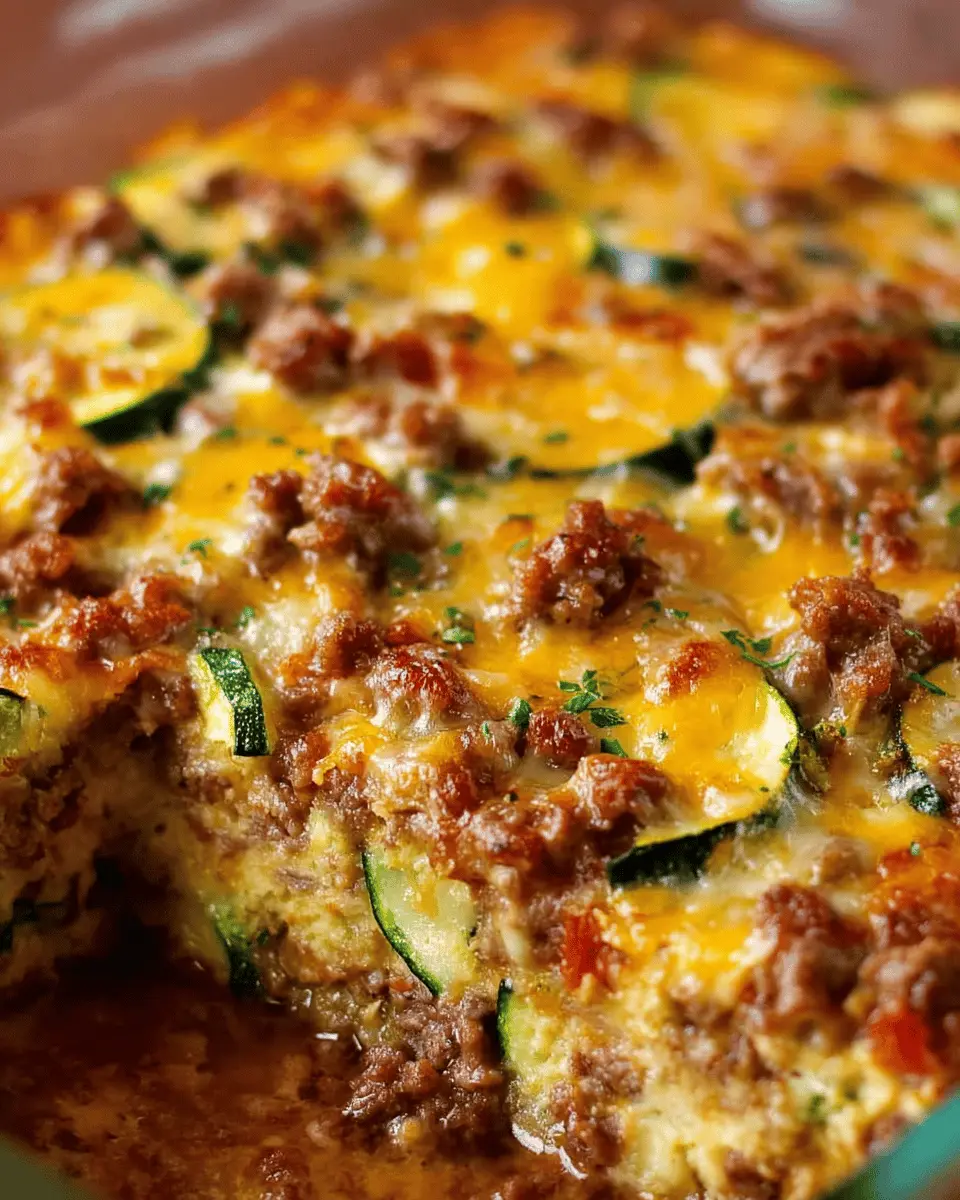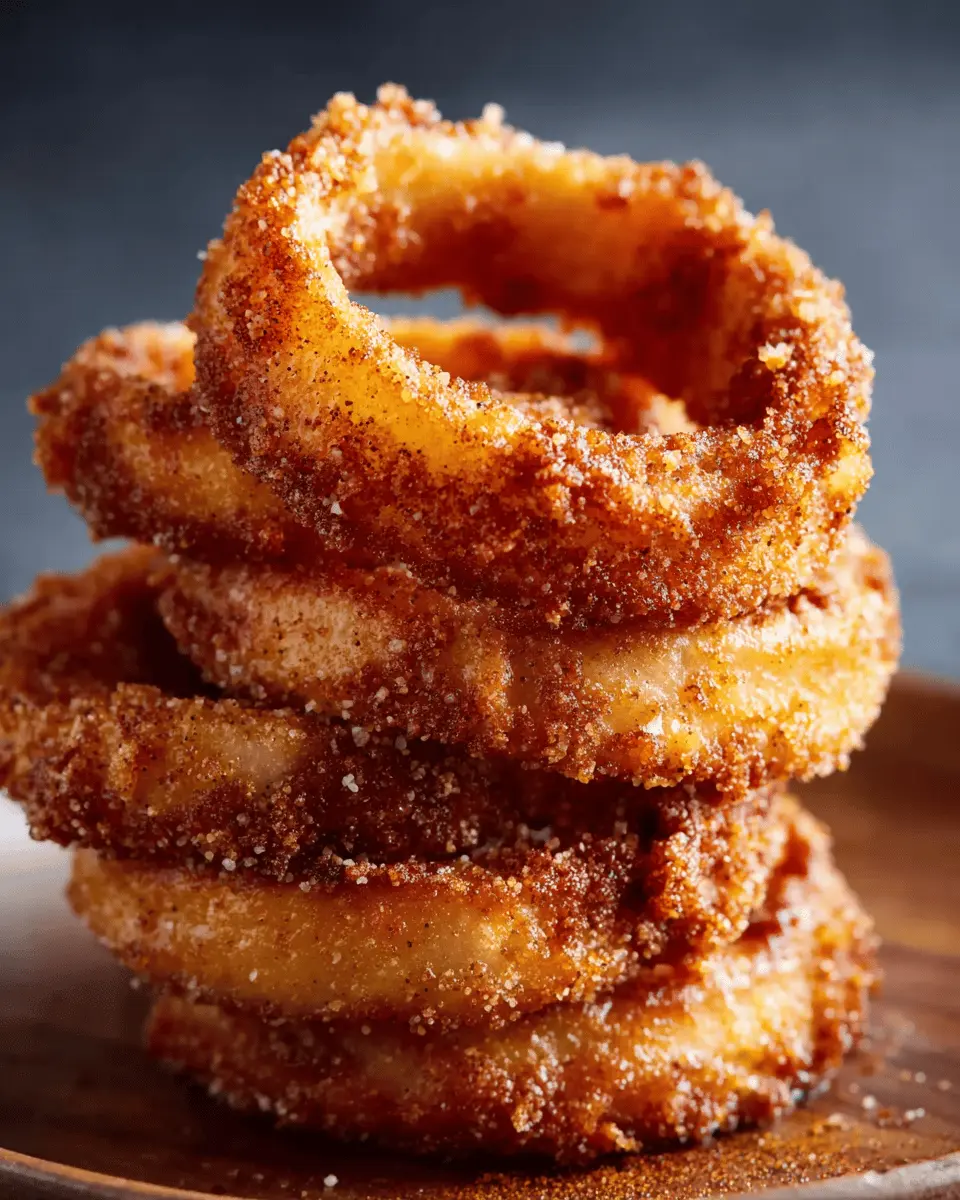There’s something magical about the smell of freshly baked bread filling your kitchen. But what if I told you that you could make a bakery-style loaf at home—without any kneading, complicated techniques, or special equipment? That’s exactly what this No-Knead Rosemary Cranberry Bread with Olive Oil & Sea Salt delivers.
This recipe is a game-changer for both beginners and seasoned bakers. It’s rustic, crusty on the outside, soft and chewy on the inside, and bursting with the sweet-tart pop of cranberries and earthy aroma of rosemary. A gentle brush of olive oil and a pinch of flaky sea salt before baking take it to the next level.
Whether you’re baking for a holiday breakfast, planning a cozy weekend brunch, or just craving something warm and homemade, this is the loaf you’ll turn to again and again. Trust me—if you’ve never made bread before, this is the place to start.
Why You’ll Love This Recipe
This bread is one of those recipes that becomes an instant favorite. The kind you’ll want to make for guests, wrap up as a gift, or keep on the counter for snacking all weekend long. Let’s talk about why it’s such a standout.
Key Benefits
-
Effortless to make – No stand mixer, no kneading, no fuss. The dough practically makes itself overnight.
-
Incredible texture – Crusty outside, soft and chewy center. It’s everything you want in an artisan loaf.
-
Flavor-forward – Sweet cranberries, savory rosemary, and a golden crust brushed with olive oil.
-
Make-ahead friendly – The dough ferments slowly overnight, which means less hands-on time and more flavor.
-
Perfect for the holidays – It looks beautiful on a table and tastes even better toasted with butter or soft cheese.
Suitable For
-
Holiday meals – Serve it for breakfast, brunch, or with a festive cheese board.
-
New bakers – No-knead means no fear. If you can stir a spoon, you can make this bread.
-
Make-ahead planners – The overnight rise gives you flexibility, and the finished loaf freezes beautifully.
-
Family gatherings – Warm, inviting, and designed to be shared.
Ingredients for No-Knead Rosemary Cranberry Bread
You don’t need anything fancy for this bread—just a few pantry staples and one or two flavor-packed additions.
Core Ingredients
-
All-purpose flour – The base of the dough. Regular flour works perfectly here—no specialty flours needed.
-
Salt – Enhances the flavor and supports the fermentation process.
-
Instant yeast – A small amount goes a long way thanks to the long rest time.
-
Dried cranberries – Sweet, chewy, and the perfect contrast to the herby rosemary.
-
Fresh rosemary – Brings a woodsy, aromatic note that makes this bread shine.
-
Warm water – Activates the yeast and brings everything together.
-
Olive oil – Adds richness to the dough and a beautiful finish to the crust.
-
Flaky sea salt – For that irresistible salty crunch on top.
Substitutions and Tips
-
Can’t find fresh rosemary? Dried works too. Use 1 teaspoon in place of 1 tablespoon fresh.
-
Want to change it up? Try raisins or chopped dried apricots instead of cranberries.
-
Prefer a nuttier flavor? Add ½ cup of chopped walnuts or pecans for crunch.
-
Bread flour instead of all-purpose? Totally fine. It’ll give a chewier texture, but both are delicious.
-
No instant yeast? Active dry yeast works—just dissolve it in the warm water before mixing.
Best Cranberries and Rosemary for Flavorful Bread
The two flavor stars in this loaf deserve a little extra attention. They may seem simple, but choosing the right form of each can make a big difference.
For cranberries, dried is the way to go. They’re easy to mix into the dough and won’t release excess moisture during baking. If yours are very dry, soak them briefly in warm water or orange juice and pat dry before adding. This helps plump them up without making the dough too wet.
When it comes to rosemary, fresh is best. It adds a vibrant, aromatic punch and looks beautiful in the finished loaf. But if fresh rosemary isn’t available, don’t worry—dried rosemary can absolutely work. Just crush it slightly with your fingers to release the oils and use about one-third of the fresh amount.
These two ingredients together are what make this bread so uniquely flavorful—sweet, savory, and just the right amount of festive.
Kitchen Tools You’ll Need
One of the best things about this recipe is how low-tech it is. You don’t need a mixer or a bread machine—just a bowl, your hands, and a Dutch oven (or something similar).
Must-Have Tools
-
Large mixing bowl – For stirring together the dough. Make sure it’s big enough for the dough to rise.
-
Wooden spoon or spatula – You’ll be mixing, not kneading, so no stand mixer needed.
-
Parchment paper – Helps you transfer the dough into the pot without sticking or burning.
-
Dutch oven or heavy lidded pot – This is the key to that crispy artisan crust. It traps steam and mimics a professional bread oven.
Nice-to-Have Tools
-
Dough scraper or bench knife – Great for shaping the sticky dough without over-handling it.
-
Kitchen scale – Not essential, but it can make measurements more precise.
-
Basting brush – For brushing olive oil over the dough before baking.
-
Wire cooling rack – Helps the bread cool evenly and keeps the crust crisp.
With just these tools and a little patience, you’ll have a beautiful, crusty loaf that looks like it came from a bakery—but it came from your kitchen.
How to Make No-Knead Rosemary Cranberry Bread with Olive Oil & Sea Salt
This is one of those recipes that looks impressive but couldn’t be simpler. If you’ve never baked bread before, don’t worry—you’re not alone, and this one is incredibly forgiving. The key is patience and a bit of trust in the process. Let’s walk through it together.
Step 1: Mix the Dough (Night Before or 8–18 Hours in Advance)
In a large mixing bowl, whisk together 3 cups of all-purpose flour, 1½ teaspoons of salt, and ½ teaspoon of instant yeast. Add 1 cup of dried cranberries and 1 tablespoon of finely chopped fresh rosemary (or 1 teaspoon dried, if that’s what you have on hand).
Next, pour in 1½ cups of warm water and 1 tablespoon of olive oil. Stir everything together with a wooden spoon or spatula until a sticky, shaggy dough forms. It’s going to look messy—and that’s perfect. Don’t try to make it smooth. You’re not kneading, just combining.
Cover the bowl tightly with plastic wrap or a lid and set it aside at room temperature. Let it rest for 12 to 18 hours. You’ll wake up (or come back) to a beautifully bubbly, risen dough that’s ready for baking.
Tip: If your kitchen is on the cooler side, aim for closer to 18 hours. A warm environment will speed things up a bit.
Step 2: Shape and Rest
Once your dough has had its long rest, it’s time to shape it—but not knead it. This is where things get a little sticky, literally.
Lightly flour your countertop and gently turn the dough out of the bowl. It’s going to be soft and a bit loose, so dust your hands with flour to help you work with it. Carefully shape the dough into a round ball. Don’t stress about perfection—it’s meant to look rustic.
Place the dough onto a piece of parchment paper and cover it loosely with a clean kitchen towel. Let it rest for 30 to 45 minutes while you preheat your oven.
Step 3: Preheat the Oven
This step makes all the difference in getting that crisp, bakery-style crust. About 30 minutes before baking, preheat your oven to 450°F (230°C). Place your Dutch oven or heavy lidded pot inside while it heats up. You want that pot piping hot before the dough goes in—it’s what creates the steam that gives the bread its crusty exterior.
Step 4: Bake the Bread
Carefully remove the hot Dutch oven from the oven. Using the parchment paper, lift the dough and lower it right into the pot—parchment and all. Don’t worry if it looks a little loose. The hot pot will take care of that.
Brush the top of the dough with a bit of olive oil and sprinkle with flaky sea salt. This gives the crust a golden sheen and a pop of flavor.
Cover with the lid and bake for 30 minutes. Then, remove the lid and bake for another 10 to 15 minutes, until the loaf is deep golden brown and sounds hollow when tapped.
Step 5: Cool and Serve
This is the hardest part—waiting. Once the bread is done baking, carefully lift it out of the pot using the parchment paper and transfer it to a wire rack.
Let it cool for at least 30 minutes before slicing. This gives the interior time to set properly and keeps the texture light and airy.
Tips for Success
-
Give it time – The long fermentation is what develops the flavor and texture. Don’t rush it.
-
Use parchment paper – This makes it so much easier to transfer the dough without it sticking or falling apart.
-
Don’t overwork the dough – Resist the urge to knead or shape too much. This bread is meant to be rustic.
-
Preheat your Dutch oven – A hot pot creates steam, which is essential for that artisan crust.
-
Cool completely before slicing – Cutting too early can make the inside gummy.
How to Store No-Knead Rosemary Cranberry Bread
This bread is best the day it’s baked, but it stores surprisingly well when handled right.
At Room Temperature
Wrap the cooled loaf in a clean kitchen towel or place it in a paper bag. It’ll stay fresh and crusty for up to 2 days. Avoid plastic, which softens the crust.
In the Refrigerator
Bread tends to dry out in the fridge, so it’s not ideal. If you must refrigerate it, wrap it tightly in foil, then reheat briefly in the oven to refresh the crust.
Freezing Tips
Want to save a loaf for later? Wrap it tightly in plastic wrap and then foil, or place it in a zip-top freezer bag. Freeze for up to 2 months. To serve, thaw at room temperature, then warm in a 325°F oven for 10–15 minutes to revive the crust.
Frequently Asked Questions (FAQs)
Can I use fresh cranberries instead of dried?
Fresh cranberries release a lot of moisture, which can throw off the texture of the dough. Dried cranberries are ideal for even distribution and flavor.
Do I really need a Dutch oven?
A Dutch oven is the best tool for creating the steam needed for that crispy crust. If you don’t have one, try using a heavy pot with a tight-fitting lid, or place a baking dish with hot water on the bottom rack of your oven to simulate steam.
Can I make this gluten-free?
You can try using a 1:1 gluten-free flour blend, though the texture may vary. Be sure to follow the same steps and give the dough plenty of time to rest.
Can I skip the long rise?
Unfortunately, no. The long, slow fermentation is what builds the structure and flavor in this bread. It’s worth the wait, promise.
Related Recipes
If you loved this rosemary cranberry bread, you might enjoy these other homemade treats:
-
Rustic No-Knead Rosemary Garlic Bread – Infused with garlic and herbs for a savory twist.
-
Cheese Bread Recipe – Cheesy, fluffy, and great for snacking or serving with soups.
-
Avocado Mozzarella and Tomato Grilled Cheese – A sandwich that’s perfect with slices of homemade bread.
Conclusion
This no-knead rosemary cranberry bread is a beautiful balance of simplicity and flavor. It’s warm, comforting, and the kind of loaf that makes you feel like a bread-baking pro without the stress. Whether you serve it fresh with butter, slice it for toast, or bring it to a holiday table, this bread is bound to become a go-to favorite.
Make it once, and you’ll find yourself coming back to it again and again.
Print
No-Knead Rosemary Cranberry Bread with Olive Oil & Sea Salt
- Total Time: 13–19 hours
- Yield: 1 artisan loaf (8–10 slices)
- Diet: Vegetarian
Description
A crusty, golden no-knead artisan bread infused with rosemary and dried cranberries, finished with olive oil and flaky sea salt. Perfect for holidays, cheese boards, and cozy mornings.
Ingredients
- 3 cups all-purpose flour
- 1½ tsp salt
- ½ tsp instant yeast
- 1 cup dried cranberries
- 1 tbsp fresh rosemary, finely chopped (or 1 tsp dried)
- 1½ cups warm water
- 1 tbsp olive oil (plus more for brushing)
- Flaky sea salt, for sprinkling
Instructions
- In a large bowl, combine flour, salt, and yeast. Stir in cranberries and rosemary.
- Add warm water and olive oil. Stir until a sticky dough forms. Cover and let rest at room temperature for 12–18 hours.
- Turn dough onto floured surface. Shape gently into a round. Place on parchment paper and let rest for 30–45 minutes.
- Meanwhile, preheat the oven to 450°F with a Dutch oven inside for at least 30 minutes.
- Transfer dough with parchment to the hot pot. Brush with olive oil and sprinkle sea salt. Cover and bake 30 minutes.
- Remove lid and bake another 10–15 minutes until crust is golden. Cool on a rack for 30 minutes before slicing.
Notes
- Use bread flour for a chewier texture.
- Fresh rosemary adds the best aroma, but dried can be substituted.
- Soak cranberries in warm water or orange juice to plump, then dry before adding.
- Don’t skip the long rest—it’s key for flavor.
- Prep Time: 10 minutes (plus 12–18 hrs resting)
- Cook Time: 40–45 minutes
- Category: Bread
- Method: Baking
- Cuisine: American
Nutrition
- Serving Size: 1 slice
- Calories: 170
- Sugar: 5g
- Sodium: 270mg
- Fat: 3g
- Saturated Fat: 0.5g
- Unsaturated Fat: 2.5g
- Trans Fat: 0g
- Carbohydrates: 32g
- Fiber: 2g
- Protein: 4g
- Cholesterol: 0mg

